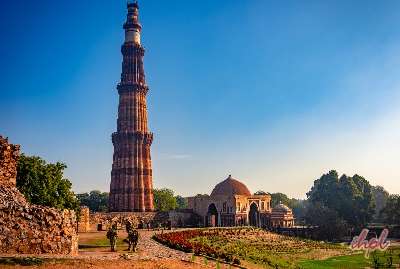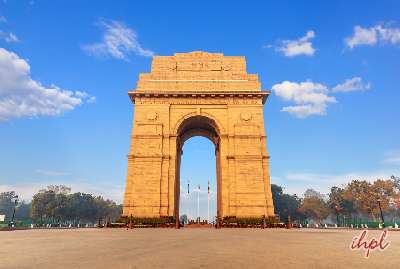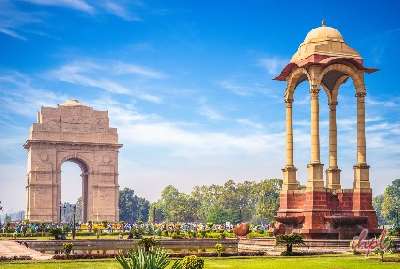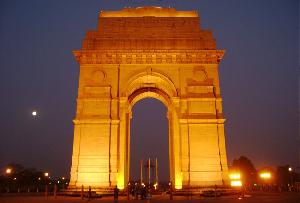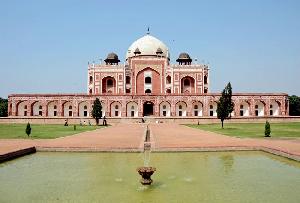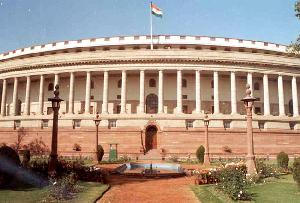India has always been known for her democratic ideals. Perhaps the most important symbol of the democracy of India is her parliament, which forms the basis for the legal and administrative wings of the Indian constitution. Thus, for most visitors to the Indian capital, the Indian parliament is a must-see.
History:
The North and South Block houses the seat of the most important offices of the Indian Government- the Prime Minister’s Office, the Ministery of External Affairs, Ministry of Defence, Ministry of Home Affairs and Ministry of Finance and is consequently the most prestigious and well-guarded monument that Delhi boasts of. That apart, the majestic architecture of the building and the wide clean roads surrounding the area is quite a feast for the eyes and gives you a feel of the aura and authority of administration. Built on either side of Rajpath, the Secretariat Buildings are the most impressive administrative buildings in the country.
North and South Block
New Delhi came into being with the shifting of the national capital from Calcutta to Delhi. A New Capital – A visible symbol of British supremacy over India was New Delhi – the ‘Newbeing added to distinguish it from the older Delhi that happened to be the capital of the Mughal Emperor. New Delhi is thus the story of an Empire in its heyday, but also of an Empire that would soon crumble. This new move demanded a new and novel architectural idiom that would uphold the glory of the Raj and yet remain quite representative of the subcontinent. Raisina Hill became the proposed site for this new grand endeavor.
Edwin Lutyens, till then a relatively little-known architect, specializing in country houses in Britain, managed by dint of enterprise and family connections to become the forerunner for architectural team ordained to design the new capital. Together with his friend Herbert Baker, he embarked on the project of designing one of the most monumental public spaces of the 20th century. The responsibility of the Secretariat buildings, now called North and South Block rested chiefly on Baker after a dispute between the two architects. Completed in 1929, North and South Block along with Rashtrapati Bhavan were built at a whooping cost of over 17.5 million rupees. Entry is prior to permission from relevant authorities. However a drive down the locality is quite permissible
Inspiration
The architecture of the North and South Block drew inspiration from the Paris and Champs-Elysées of Baron Haussmann, Wren’s unbuilt plan for London, as well as L’Enfant’s plan for Washington DC and Christopher Wren’s Royal Naval College at Greenwich. These buildings also remind one of the imperial edifices of the Union buildings Baker created in Pretoria in South Africa.
Architecture of North and South Block
New Delhi came into being with the shifting of the national capital from Calcutta to Delhi. A New Capital – A visible symbol of British supremacy over India was New Delhi – the ‘New’ being added to distinguish it from the older Delhi that happened to be the capital of the Mughal Emperor. This new move demanded a new and novel architectural idiom that would uphold the glory of the Raj and yet remain quite representative of the subcontinent. The architecture of North and South Block is characteristic of this grand endeavor that took shape under the supervision and expertise of Edwin Lutyens and Herbert Baker. The construction of the North and South Blocks were completed in 1929 and together with the Rashrapati Bhawan they cost a whooping 17.5 million rupees.
The grand sandstone buildings that constitute the North and South Block face each other with the Vijay Chowk, a huge square in between. Built of pink (for the plinth) and a butter yellow (for the walls, towers and domes) sandstone, the long classical buildings are crowned by an imposing 217 ft high dome reminiscent of the Indian Chhatri, an architectural feature unique to India- one that emerged as a result of the merger of Mughal and traditional Rajput style of architecture. Built on a plinth 30 feet high, the buildings have four sandstone columns each topped by a bronze ship sailing east, two in front of each blocks representing the dominions of the British Empire- Canada, New Zealand, South Africa and Australia. Originally these towers were intended to be twice the height of the buildings and to act as sentinels guarding the way to the inner sanctum. In the centre of the court is the Jaipur Column of red sandstone topped with a white egg, bronze lotus and six-pointed glass star of India. Across the entrance to the Great Court is a 205m wrought iron screen. The domes are decorated with lotus motifs and elephants, while the Mughal designs inspires the north and south gateways.
The buildings have four floors-each floor consisting of about 1000 rooms. Long running corridors and fountain courts characterize the buildings.
The gateway of the North Block has inscribed on it- “Liberty will not descend to a people: a people must raise themselves to liberty. It is a blessing which must be earned before it can be enjoyed”. The North Block now houses the Ministry of Home Affairs and the Ministry of Finance while the Ministry of External Affairs is seated in the South Block.
Inspiration
The architecture of the North and South Block drew inspiration from the Paris and Champs-Elysées of Baron Haussmann, Wren’s unbuilt plan for London, as well as L’Enfant’s plan for Washington DC and Christopher Wren’s Royal Naval College at Greenwich. These buildings also remind one of the imperial edifices of the Union buildings Baker created in Pretoria in South Africa.
Fast – Facts:
Location- North and South Block is Adjacent to the Rashtrapati Bhavan on either side of Vijay Chowk on the western end of Rajpath, Raisina Hill. Also Known as- British Secretariat Buildings.
Best Time to Visit- The Secretariat buildings remain open on all days, but the best time to visit this part of New Delhi is on the 26th January- the Republic Day of India or 29th January when The Beating of the Retreat Ceremony takes place at Vijay Chowk.
Entry- Entry and photography is free but prior to permission from relevant authorities.
Mode of Transport-Public buses, auto-richshaws, taxis or metro rail can be availed to reach North and South Block. Each of these, are easily and frequently available.
Nearest terminals- The nearest rail station is New Delhi station, the nearest metro station is Central Secretariat and the nearest airport is Indira Gandhi International Airport.
Nearest City Landmark- Connaught Place, the heart of New Delhi is very near and is the hub of the best eateries, shops and markets.
Design
Designed by the celebrated British architect Herbert Baker, the Secretariat Building at Delhi is a combination of the Mughal, Rajput as well as British styles of architecture. Adorned with a dome like structure that gives a unique prominence to the building, the North and South Blocks are important from an architectural point of view as well.
Nearby Attractions
Rastrapati Bhawan- A majestic architectural creation in sandstone, the official residence of the Indian President is unmatched in grace, beauty and grace. During the British rule, this was the residence of the Viceroy of India.
Parliament House- A circular building with an imposing exterior colonnade and an interior three-pointed plan with a central, domed space, the seat of the two houses of the Indian Parliament was conceived by Herbert Baker
India Gate- Originally called the War Memorial Arch, India Gate commemorates the Indian soldiers who sacrificed their lives during the First World War. On its walls are inscribed the names of 60,000 men who fell fighting for the British Empire. This archway completes the Rajpath, the central axis of Indian Central Government.
Other Nearby Attractions
- National Museum
- Jantar Mantar
- Gurudwara Bangla Sahib
- Hanuman Mandir
- National Stadium
- Connaught Place




